Columns

GROWING UP, I read tons of historical fiction and often imagined the lives and times of my ancestors. My curiosity stemmed, in no small part, from my family, who dragged us to every available Black history and Black art museum. Whether visiting California’s first and only Black town, where my great-great-grandparents had bought land; making a pilgrimage to the National Underground Railroad Freedom Center during a family reunion; taking Black history bus tours; or hearing family stories from my grandmother and great-aunt, Black history was never far from our everyday lives.
Recently, technological developments and my growing archival research skills have enabled me to dig further into our family history. As DNA ancestry testing and digitized documents have become more widespread, I have been able to find graves and documents that could have been lost to history. The past, for me, has become even more close at hand as a crucial way of understanding the present.
Relating to the past in this way—an approach that resonates with Black families across the diaspora—stands in stark contrast to ongoing efforts to erase, distort, and lie about history.
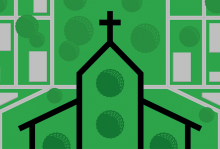
BACK IN FEBRUARY, I volunteered to drop off Lenten kits to members of the church I started attending several months earlier. Being relatively new to the city and congregation, having recently moved to the area, I was unfamiliar with most of the people on my list, as well as the neighborhoods, street names, apartment complexes, and long-term care facility indicating their residences. Assisting with Ash Wednesday before the pandemic might have been a fairly routine way of familiarizing myself with fellow parishioners—one of those innumerable little face-to-face encounters that slowly builds familiarity and trust in a church. This year, of course, there was none of that. My volunteer experience was isolated and individual. Ferrying containers of ashes, devotional booklets, and craft activities to people’s doorsteps and mailboxes, I saw no one, save the care facility receptionist.
This almost completely impersonal experience was also the most powerful ecclesial encounter I have had throughout the pandemic—the one that felt most like church.
During the course of COVID-19’s restriction of in-person worship, I went inside a church only a handful of times. Once to say goodbye to the congregation I left when I moved from Washington, D.C.; once to get ordained in my hometown; twice to pick up liturgical kits at the church I started attending in my new city; and once to guest preach at this church, standing inside a sealed pulpit and preaching to a mostly empty sanctuary. All visits, except for the kit pick-ups, were livestreamed. I initially thought that being back inside a church after a forced separation would be some awe-inspiring faith moment—like coming home to God. What my experience this year taught me is that we never truly left. It sounds cliché, and maybe a bit untrue—after all, though the church is the body of Christ, the people and not the four walls, Zoom is not people. Virtual is just that: virtual. But that difference is precisely what I experienced when making Lenten deliveries. Driving to people’s homes, walking along their streets, encountering new neighborhoods (or rediscovering old ones, as I did upon realizing that people whose names I had seen only on screen were around the corner from me)—with each delivery, I felt like I was drawing invisible lines of connection between my residence and those of my fellow church members, my body and their bodies, locating us together in the world for the first time. It felt like communion.

I WAS A weird kid who faithfully read the syndicated “Hints from Heloise” newspaper column and the household tips in my mom’s many women’s magazines. I loved how a mundane problem in everyday life could be cheerfully solved with vinegar and “elbow grease” or the strategic deployment of a couple of rubber bands.
This was before Martha Stewart famously built an empire providing perfection-oriented household advice, such as mopping tips that note “sparkling floors begin with the correct tools.” In contrast, the advice in my childhood was humbler, with a how-to/can-do spirit that acknowledged that making a home clean and safe, and keeping a family fed, clothed, and nurtured on a budget is difficult and time-consuming.
When I was young, this was still sometimes called “women’s work.” Religious conservatives and organizations such as Focus on the Family added a faith twist—a woman’s role in the home was sacred duty (based on Jesus’ lost parable of the submissive helpmate?). The term “women’s work” is less common now, but studies show that in households where both a male and female partner are employed outside the home full time, the woman is still more likely to do more of the domestic work.
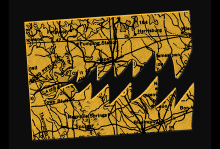
WHEN I WAS 8 years old, in June 1998, three white supremacists lynched James Byrd Jr., a Black man in Jasper, Texas. After offering him a ride in their truck, they beat him, desecrated him, chained him to their vehicle, dragged him to his dismemberment and eventual death, and deposited parts of his body in front of a Black church to be found on Sunday morning. I remember hearing about the murder on the evening news and having a newly personal sense of the geography of racial terror. As a child living in California, I could not locate Jasper on a map, but its name, and Byrd’s, were forever fixed in my mind.
Earlier this year, I realized that my great-grandmother was around that same age when, in May 1918, white supremacists lynched Mary Turner and a dozen other Black people, including the baby they cut out of Turner’s abdomen. I wonder if my great-grandmother, as a child, heard the news, and how it affected her. In her case, the lynchings happened not three states but three hours from where she lived in Georgia. Unlike in Byrd’s case, there were no charges, arrests, trials, or convictions of the known and suspected murderers behind these lynchings. I wonder if and how the killings—and the impunity allowing the lynchers freedom of movement—shaped her sense of the landscape.
In Demonic Grounds: Black Women and the Cartographies of Struggle, geographer Katherine McKittrick writes that “Black matters are spatial matters.” McKittrick identifies the social production of space—how landscape is not a fixed background but is defined by relationships. Fugitivity, precarity, and possibilities of life and death are mapped realities that follow social relationships.
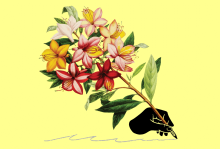
THIS SPRING, MY mother and I did something we have not done together since I was in junior high school: a creative, collaborative liturgical project. Starting when I was about 4 years old, my mother and I would make Christmas cards each year to give to our family and friends. She provided the text, usually in the form of her own biblically and seasonally inspired poetry, and I, an avid drawer, would illustrate her words. We continued this tradition for more than 10 years.
When the church I now attend invited contributions for a crowd-sourced congregational Lenten devotional booklet this year, my mother came up with an idea. She was, as she wrote, “A mom inspired by a thought—as Paul wrote letters to his beloved children and friends in faith ... so could I write a letter to my daughter.” Following the model of the Pauline epistles, my mom wrote me a letter of spiritual encouragement and advice on navigating wilderness, a key feature of both Lent and life. I decided to respond and thank her with a letter of my own. Together, the individual expressions of our relationship became a communal project.
In contemplating our project, I see a creation whose significance is more than the sum of its parts, so to speak. The joint submission of correspondence between my mother and me is not simply a nostalgic return to a lapsed family tradition. Rather, it is a reflection of a profound theological aspect of our relationship: the cultivation of selves in the space of love.

I FIND MYSELF thinking about the significance of “firsts,” the role of faith in the morality of the nation, and the place of race and gender in that project. Vice President Kamala Harris’ ascent to one of the highest seats of political power is historic, unprecedented, and awe-inspiring. Like Barack Obama before her, it is a first that has ushered in, for many, a renewed faith in the nation. Multiply the emotional impact of that first by whatever number captures the firestorm of the past four years, and that faith easily transforms into a belief that “morality” has been secured and that things are going to be, basically, okay.
This train of thought is, I believe, dangerous and wrong. I do not discount the feelings Harris evokes. The emotional impact of Harris’ election registers for me very personally as a Black woman. When I initially heard that Joe Biden and Kamala Harris had won the election, my first thought was exhilarated shock at Trump’s defeat. Then, as that fact sunk in, I realized that this outcome meant the election of a woman of color—a Black woman, a woman of South Asian descent—to the vice presidency of the United States. Weeks later, the words still seemed somewhat strange, as if my brain was having trouble wrapping itself around the reality. My inability to readily speak her new position reflects to me the depth of her significance, and the change it portends for how I and future generations of Black and brown girls and women will be able to envision and speak of ourselves. I pause, however, at the unexamined triumphal connections being made between Harris, morality, and political futures.

WHAT IS REST and what does rest look like during a time of pandemic?
Over the past year, the multiple pandemics we have faced have upended many things, not least of which has been our language. “Essential” has been revealed to be simply another word for “disposable,” with “essential frontline workers” being those whose lives society deems expendable, not irreplaceable. “Safe” has been shown to be so shoddy, subjective, and circumscribed a reality in this country that protesting for Black lives in a pandemic is indeed safer than failing to protest at all. And “rest”—what is rest?
Many of us were struggling with healthy notions and practices of rest prior to COVID-19. Now? “Rest” seems both undefined and unattainable. Biblical images of rest have often been interpreted to emphasize separation, distance, and juxtaposition. For example, Jesus withdrawing from the crowds is often read as modeling rest distinct from the activity, the hubbub, the movement, the people. There is value in this reading of rest, particularly in how it spatially mediates self-care (thus, “retreats”). The thing about pandemics, however, lies in the pan- prefix denoting “all” or “every.” As safer-at-home policies and seemingly limitless racial violence make clear, whether facing COVID or white supremacy, withdrawal to elsewhere is not an option. So, what does rest mean when one cannot “retreat,” spatially or politically or otherwise?

EARLIER THIS YEAR, Emancipation Memorial in my neighborhood of Lincoln Park in Washington, D.C., became the target of national protests and calls for removal. Erected to great fanfare in 1876, the memorial is not a Confederate monument but an homage to Black freedom built with the hard-earned dollars of former slaves. It commemorates a sacred moment in Black history, but does so with the racist imagery—and thus fictive narrative—of Abraham Lincoln dominating a crouching, half-dressed, emancipated Black man.
I resented Emancipation Memorial each time I passed by it, but when the calls began for its removal, I faltered. Learning its history several years ago as a monument fundraised by formerly enslaved Black people forged for me feelings of connection to it, even as I recoiled at its imagery. The meaning of “home” it carried as the landmark naming my D.C. neighborhood and church intensified in light of these feelings. My complicated response led me to reflect on another structure close to home for me that has yet to be dismantled.

FOR NEARLY 50 years, Sojourners magazine has taken bold, prophetic stands to fulfill its mission—to articulate the biblical call to racial and social justice, life and peace, and environmental stewardship—by telling stories that uncover injustice and offer solutions. I’ve been drawn to this mission since I was a college student studying journalism in the mid-aughts, and I am honored to be in a position to help build on that rich tradition as Sojourners’ new editor-in-chief.
In August, we revised our policies and procedures to strengthen our editorial independence and renewed our commitment to journalism that “comforts the afflicted and afflicts the comfortable" (for more on that change, click here). Amid a racial-injustice reckoning and the most consequential presidential election of my lifetime, this commitment to the Christian mandate of truth-telling drives our work.
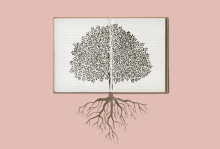
THESE DAYS, I gather strength from predictability. Being home from work amid a global pandemic with two children—a toddler and a teenager—has filled my world with inventive ways to press on while working full-time, schooling the kids, and being a graduate student myself.
I have a newfound green thumb—working with my mini-garden, I recount stories from my childhood, stories of triumph, perseverance, and restless hope. I hope my toddler clings to these stories when things seem uncertain. I am also creating new stories to share for years to come. My journal is overflowing with COVID-19 stats, sketches of plants, and day-to-day business. It has become a place I document our lives. When my children grow old, they will look to this time and wonder how we made it through or how we handled this uncertainty because they yearn for a time when things feel hopeful again. I hope my journals will help them remember and understand how we coped with a time when we self-quarantined, socially distanced, stayed six feet apart in masks.

LAST SUMMER, I started composting. What began as an economical exercise focused on reduction became, over time, a relationship based on generosity and gift. When COVID-19 interrupted my weekly routine of dropping off food scraps, I realized with a jolt that composting felt less like an act of frugality and more like bringing tribute. Unexpectedly, through composting, I had entered into relationship with the earth—and this was a recovery of something long forgotten. As Robin Wall Kimmerer urges us to remember inBraiding Sweetgrass: Indigenous Wisdom, Scientific Knowledge, and the Teachings of Plants, we exist in reciprocity with the more-than-human world.
This remembrance parallels a tactile memory I experienced last winter while running my hands through a bowl of dried black-eyed peas. The feel of the beans, almost like coins, merged with images of large, elementary numerals in my head and movement, like an abacus, from one side to another—a flash so quick and wordless I could not be sure. When it happened again a few months later, I remembered: This is how I learned to count. My grandmother—a foundational figure alive for my first 18 years—taught me to count with beans.

IN MY OWN interreligious instruction, I have become aware of the lack of discussion of Indigenous traditions. The very way knowledge is conceived of is at play here. Margaret Kovach articulates an Indigenous epistemology in her essay “Emerging from the Margins” as “fluid, non-linear, and relational. Knowledge is transmitted through stories that shape shift in relation to the wisdom of the storyteller at the time of the telling.”
As I have engaged Indigenous communities and scholarly voices in my work, I have sought to:
Bust up the category of religion. By this I mean I try to interrogate how interreligious encounters define religion and who is invited to the table, or what parts of a person we invite.
Since I teach at a Christian seminary, religion as defined by doctrinal and scriptural sources takes precedence. I found that many of my Christian students—for instance, those from Tonga—had a deep connection to Indigenous practices woven into their identity. But at seminary this aspect was reduced to “culture” and not given a place at the table. I learned to ask students to self-identify and opened the space to recognize that all forms of their spiritual practice were valid sources of scholarship. They were not asked to cancel or erase parts of their spiritual practice that were considered by others as less important.

MY GRANDMOTHER CAME to me in a dream. It was the first day of the COVID-19 pandemic and I knew I would not be able to visit her. My daughter had just come down with pneumonia; I did not want to put my grandmother at risk. When she came to me in my dream, through the front window, covered in a thin curtain, I could see her shadow as she walked onto my porch. As I neared the door, through the window I could see that she did not knock but instead walked over to the flowers on my porch. They were a gift from her to me. She touched each one and leaned in close as if in conversation with them. She never turned to knock on my door. I woke up.
I called my grandmother to recount the dream. She told me she had hoped I was taking care of the plants. Ruda (rue), sábila (aloe vera), and Corona de Cristo (Christ plant) adorn my front porch. I’ve since added rosemary, jade, and a few others. Care of the earth has always been imperative. In our current times, survival will depend on how we treat what God created to meet our basic needs.
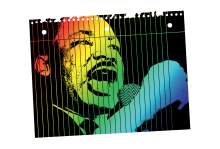
EARLIER THIS YEAR, I almost did not finish writing the sermon I was scheduled to preach at a special Martin Luther King Jr. Day Social Justice Shabbat service. Usually, I am able to bring sermons to a close without problem; this time, I struggled. Really struggled. Instead of focusing thematically on racism, poverty, war, or any number of issues King spoke out against, I had decided to preach on fear. I felt called to name fear as the root issue beneath so many others, something we struggle with individually and collectively. Fear of scarcity, fear of the unknown, fear of the “other”: the immigrant, the unarmed black person, the queer, the Sikh, the Muslim, the Jew, or the white person now encountering you in your queer, black, immigrant, brown, Muslim, Sikh, or Jewish body.
I found that once I started being honest about the fears we hold and the fears we face, I could barely turn the corner, in a manner of speaking, toward hope.
Eventually, I was able to theologically pivot my sermon and conclude positively. However, that experience of being spiritually stumped with writer’s block said more to me than any happy ending ever will. Rather than yielding answers, my sermon gave me questions, which continue to resonate in the midst of a global pandemic.

FOR MANY INVOLVED in interfaith engagement, the goal is to seek common ground and values. The assumption is that differences are the source of conflict and peace is predicated on seeing each other as having more in common than different. This is a framing I hear again and again. It is certainly a necessary first step for communities that have narrow ranges of engagement with one another. For instance, it is powerful to watch students in my interfaith classes at Christian seminaries recognize how Islam and Christianity share a reverence for Christ.
But there are reasons we need to move beyond this mere appreciation of commonalities between religious traditions as the foundation for interreligious engagement.
Episodic empathy. Students and community leaders often develop a profound empathy when they engage with another tradition. However, if we don’t teach tools for navigating difference between communities, the empathy can become narrowly tied to the limited episodes of encounter, which are often facilitated by third parties. Does this empathy move from an affect of appreciation in that moment into an operationalized form of engagement across difference? When a crisis occurs and there is a rise in hatred, does the mere “common ground” approach promote behavior of deep allyship for when a community is targeted for hate and violence?
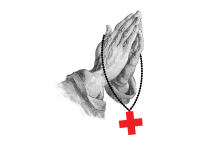
MY HUSBAND AND I are privileged to have health care for ourselves and our children. While access to health care is a serious and growing concern in our nation, as well as in our own state of Texas, we realize what a privilege it is to afford, even if barely, health care through our respective employers.
Not too long ago my husband was rushed to the emergency room, and later ICU, in a near-diabetic coma. Last year, we were heartbroken over our toddler’s unexplained seizures. It took nearly four months before she was seen by a neurologist and another six weeks to be able to get an MRI. Two more months passed before we could return to the neurologist for results. For more than eight months, we had to wait on an answer, while our faith was stretched thin. When would God show up?
According to The Commonwealth Fund, Texas ranks 49th of the 50 states for worst health care in terms of access, outcomes, and costs. Texas has also opted not to expand Medicaid eligibility, which has had devastating consequences in our communities. Our elders will say that faith is what keeps them alive when the health care system has repeatedly failed them. Younger generations will say we should not have to choose between groceries, child care, and unpaid health care bills. We have been to the pediatrician, therapy, primary care, specialist, emergency room, and ICU more than we would like.
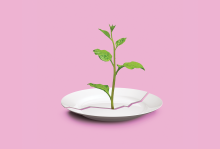
FOR MUCH OF my life I thought of Lent primarily as a season of personal piety, a self-contained period of reflection on individual sin and repentance. This penitential practice was limited in both scope and duration: It had little to do with others apart from me and God, and its impact did not extend beyond Easter. I approached a central component of Lent—the fast—like a trial, a test of willpower that pitted God against some “thing” I had given up, often a food (usually cheese or dessert). Much to my chagrin, in this personal test of will, God did not always win out. Overall, I was grateful and relieved each year when Lent ended.
Two years ago, things changed. As a dairy and meat aficionado who unexpectedly found herself a convert to vegetarianism and pondering veganism, I suddenly had a new relationship with chosen fasts. (The cause: Eating Animals, a book on factory farms written by Jonathan Safran Foer, collaborating with Jewish ethicist Aaron Gross. Read at your own dietary risk.) Vegetarianism helped me engage fasting as something internally motivated by ethical and spiritual concerns, rather than externally imposed. Participating in my church’s annual Daniel Fast later that year deepened this new experiential understanding. Based on Daniel 1 and featuring weekly 12-hour periods with no food, this fast helped me experience how fasting is not about willpower, but surrender. It taught me about hubris, humility, and moment-by-moment reliance upon God, which often involved other people.

I SAT DOWN with a co-worker to talk about presence and how to make God manifest in seasons that task us with injury, depression, and even death. Seasons of impeachment hearings, 700 missing women from ICE custody, and children still detained at detention facilities begin to create sinkholes in our spirits. My co-worker likened these experiences to a leaf floating on the waters of a raging river. The leaf is carried by the current without real direction, yet the leaf endures. A season of raging rivers has taken a toll on my faith, has created holes in the fabric of my believing. Every day I ask, where is God in this?
For the last couple months, I have found it hard to articulate my feeling of suspended belief. As a poet, a writer, a lover of words, there is a tension with sharing that information in words. I’ve begun to explore other media for translating these feelings. In November, I taught myself to sculpt paper. I’m not the best at it, because I’m tempted to create words to explain these images, but I need to let the image do most of the work. There is a beauty in doubt, a beauty that makes God manifest through our hands when we can’t articulate it with our voices or our words.
What do I look like inside, in wavering belief? Where do I find God in this? God finds me working meticulously into the morning, at a loss for words, but with an X-Acto knife cutting intricate curves and penetrating delicate layers of paper to make manifest the interior of myself.
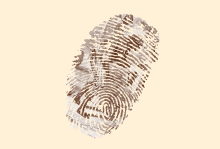
TO ENTER THE main history galleries of the Smithsonian’s National Museum of African American History and Culture (NMAAHC), you have to descend. A glass elevator carries you down through six centuries of history, dates written on walls like exposed strata in the earth. The past, we are reminded, lies not behind us but beneath us.
The weight of your passage and what lies ahead does not hit you until you step out of the elevator and emerge to the 1400s. You have arrived in a trans-Atlantic world as yet unmade, a geography not yet drawn by greed, suffering, and death. You will return to the surface and the present slowly, and only by walking the mile-and-a-half-long exhibition corridor on a winding route through slavery to an unsecured freedom.
No matter how many times I take this journey, it never becomes familiar.
The emotional shock of history is too great, contained in the thousands of everyday items on display: tiny, child-sized shackles; pieces of an excavated slave ship; an entire slave cabin, transplanted from South Carolina; a small silver box that held one man’s treasured possession, his free papers; Harriet Tubman’s lace shawl, given to her by Queen Victoria. Emmett Till’s casket.
NMAAHC, or the “Blacksonian,” as I like to call it, makes explicit what is sometimes only gestured to by other institutions: the sacredness of history.
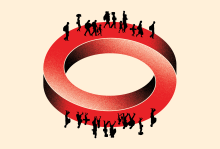
AMERICA'S OPENNESS TO refugees has been a distinct feature of our country from its foundation. Our nation was established by communities facing discrimination elsewhere for their religious practices. In the periods when the country was not open to refugees and asylum seekers, such as during the Holocaust, it later became clear that we were on the wrong side of history.
The Trump administration announced this fall an annual admissions ceiling of 18,000 refugees for the next fiscal year, its third straight year of drastic reductions and a historic low. By comparison, almost 85,000 refugees were admitted in President Obama’s last year in office. Trump’s actions come at a time when the number of people fleeing conflict around the world is the highest since World War II.
Faith-based organizations in the United States have been at the forefront of refugee resettlement. The Trump administration decision threatens the already precarious structures around resettlement, which are largely religiously based. For many, the scriptural obligation to care for the stranger is a core religious belief. By having this capacity for service undercut, in many ways the faithful—across the spectrum from conservative to progressive—are unable to fulfill their religious obligations for care. The administration’s refusal to engage the many faith-based leaders and organizations who called for more, not less, openness to welcoming refugees decries its alleged commitment to religious freedom.